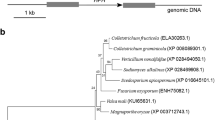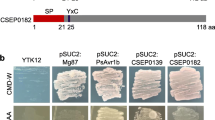Abstract
Colletotrichum scovillei, a member of the Colletotrichum acutatum species complex, causes severe anthracnose of pepper fruit, reducing yield and quality. However, the molecular mechanisms underlying its pathogenesis are unknown. Ste7 kinase in the Fus3/Kss1-related mitogen protein kinase signaling pathway plays an important role in plant infection by phytopathogenic fungi. In this study, the function of CsSTE7, an ortholog of Ste7, was investigated in C. scovillei using a targeted gene deletion mutant (ΔCsste7). Compared to the wild type, ΔCsste7 had normal mycelial growth, but conidial morphology, germination of conidia, and tolerance to cell wall integrity and osmotic stresses were defective. Importantly, ΔCsste7 was completely defective in appressorium formation and causing anthracnose on pepper fruits. These defects were restored in the complemented strain (Csste7c). The results suggest that CsSTE7 is essential for development and pathogenicity of C. scovillei.







Similar content being viewed by others
References
Bardwell L, Cook JG, Chang EC, Cairns BR, Thorner J (1996) Signaling in the yeast pheromone response pathway: specific and high-affinity interaction of the mitogen-activated protein (MAP) kinases Kss1 and Fus3 with the upstream MAP kinase kinase Ste7. Mol Cell Biol 16:3637–3650. https://doi.org/10.1128/MCB.16.7.3637
Bayram Ö, Bayram ÖS, Ahmed YL, Maruyama J, Valerius O, Rizzoli SO, Ficner R, Irniger S, Braus GH (2012) The aspergillus nidulans MAPK module AnSte11-Ste50-Ste7-Fus3 controls development and secondary metabolism. PLoS Genet 8:e1002816. https://doi.org/10.1371/journal.pgen.1002816
Brown T (1993) Southern blotting. Curr Protoc Mol Biol 21:2–9. https://doi.org/10.1002/0471142727
Caires NP, Pinho DB, Souza JSC, Silva MA, Lisboa DO, Pereira OL, Furtado GQ (2014) First report of anthracnose on pepper fruit caused by Colletotrichum scovillei in Brazil. Plant Dis 98:1437–1437. https://doi.org/10.1094/PDIS-04-14-0426-PDN
Chen RE, Thorner J (2007) Function and regulation in MAPK signaling pathways: lessons learned from the yeast Saccharomyces cerevisiae. Biochim Biophys Acta Mol Cell Res 1773:1311–1340. https://doi.org/10.1016/j.bbamcr.2007.05.003
Chi MH, Park SY, Lee YH (2009) A quick and safe method for fungal DNA extraction. Plant Pathol J 25:108–111. https://doi.org/10.5423/PPJ.2009.25.1.108
Diao YZ, Zhang C, Liu F, Wang WZ, Liu L, Cai L, Liu XL (2017) Colletotrichum species causing anthracnose disease of Chili in China. Pers: Molec Phylogeny Evol Fungi 38:20–37. https://doi.org/10.3767/003158517X692788
Dixon KP, Xu JR, Smirnoff N, Talbot NJ (1999) Independent signaling pathways regulate cellular turgor during hyperosmotic stress and appressorium-mediated plant infection by Magnaporthe Grisea. Plant Cell 11:2045–2058. https://doi.org/10.1105/tpc.11.10.2045
Errede B, Gartner A, Zhou Z, Nasmyth K, Ammerer G (1993) MAP kinase-related FUS3 from S. Cerevisiae is activated by STE7 in vitro. Nature 362:261–264. https://doi.org/10.1038/362261a0
Fu T, Han JH, Shin JH, Song H, Ko J, Lee YH, Kim KT, Kim KS (2021) Homeobox transcription factors are required for fungal development and the suppression of host defense mechanisms in the Colletotrichum scovillei-pepper pathosystem. Mbio 12:10–1128. https://doi.org/10.1128/mbio.01620-21
Fu T, Lee NH, Shin JH, Kim KS (2022a) NADPH oxidases are required for appressorium-mediated penetration in Colletotrichum scovillei-pepper fruit pathosystem. Plant Pathol J 38:345–354. https://doi.org/10.5423/PPJ.OA.05.2022.0066
Fu T, Shin JH, Lee NH, Lee KH, Kim KS (2022b) Mitogen-activated protein kinase CsPMK1 is essential for pepper fruit anthracnose by Colletotrichum Scovillei. Front Microbiol 13:770119. https://doi.org/10.3389/fmicb.2022.770119
Fu T, Kang SW, Song YW, Kim KS (2023) The cell wall integrity MAP kinase signaling pathway is required for development, pathogenicity, and stress adaption of the pepper anthracnose fungus Colletotrichum Scovillei. Mycobiology 51:1–8. https://doi.org/10.1080/12298093.2023.2220171
Gu Q, Chen Y, Liu Y, Zhang C, Ma Z (2015) The transmembrane protein FgSho1 regulates fungal development and pathogenicity via the MAPK module Ste50-Ste11-Ste7 in Fusarium Graminearum. New Phytol 206:315–328. https://doi.org/10.1111/nph.13158
Han JH, Lee HM, Shin JH, Lee YH, Kim KS (2015) Role of the MoYAK1 protein kinase gene in Magnaporthe oryzae development and pathogenicity. Environ Microbiol 17:4672–4689. https://doi.org/10.1111/1462-2920.13010
He J, Sun ML, Li DW, Zhu LH, Ye JR, Huang L (2023) A real-time PCR for detection of pathogens of anthracnose on Chinese fir using TaqMan probe targeting ApMat gene. Pest Manag Sci 79:980–988. https://doi.org/10.1002/ps.7260
Jiang C, Zhang X, Liu H, Xu JR (2018) Mitogen-activated protein kinase signaling in plant pathogenic fungi. PLoS Pathog 14:e1006875. https://doi.org/10.1371/journal.ppat.1006875
Kang BC, Kole C (eds) (2013) Genetics, genomics and breeding of peppers and eggplants. CRC Press, Boca Raton, FL, USA. ISBN: r-13: 978-1-4665-7746-6
Kato S, Endoh H, Masuhiro Y, Kitamoto T, Uchiyama S, Sasaki H, Masushige S, Gotoh Y, Nishida E, Kawashima H, Metzger D, Chambon P (1995) Activation of the estrogen receptor through phosphorylation by mitogen-activated protein kinase. Science 270:1491–1494. https://doi.org/10.1126/science.270.5241.1491
Kim S, Park SY, Kim KS, Rho HS, Chi MH, Choi J, Park J, Kong S, Park J, Goh J, Lee YH (2009) Homeobox transcription factors are required for conidiation and appressorium development in the rice blast fungus Magnaporthe oryzae. PLoS Genet 5:e1000757. https://doi.org/10.1371/journal.pgen.1000757
Kleemann J, Rincon-Rivera LJ, Takahara H, Neumann U, van Themaat EVL, van der Does HC, Hacquard S, Stüber K, Will I, Schmalenbach W, Schmelzer E, O’Connell RJ (2012) Sequential delivery of host-induced virulence effectors by appressoria and intracellular hyphae of the phytopathogen Colletotrichum Higginsianum. PLoS Pathog 8:e1002643. https://doi.org/10.1371/journal.ppat.1002643
Lee KH, Gumilang A, Fu T, Kang SW, Kim KS (2022) The autophagy protein CsATG8 is involved in asexual development and virulence in the pepper anthracnose fungus Colletotrichum Scovillei. Mycobiology 50:467–474. https://doi.org/10.1080/12298093.2022.2148393
Levin DE (2005) Cell wall integrity signaling in Saccharomyces cerevisiae. Microbiol Mol Biol Rev 69:262–291. https://doi.org/10.1128/mmbr.69.2.262-291.2005
Martínez-Soto D, Ruiz-Herrera J (2017) Functional analysis of the MAPK pathways in fungi. Rev Iberoam Micol 34:192–202. https://doi.org/10.1016/j.riam.2017.02.006
Nadal-Ribelles M, Islam S, Wei W, Latorre P, Nguyen M, de Nadal E, Posas F, Steinmetz LM (2019) Sensitive high-throughput single-cell RNA-seq reveals within-clonal transcript correlations in yeast populations. Nat Microbiol 4:683–692. https://doi.org/10.1038/s41564-018-0346-9
Ogbolumani OA, Nwulu NI (2022) A food-energy-water nexus meta-model for food and energy security. Sustain Prod Consum 30:438–453. https://doi.org/10.1016/j.spc.2021.12.019
Oo MM, Lim G, Jang HA, Oh SK (2017) Characterization and pathogenicity of new record of anthracnose on various Chili varieties caused by Colletotrichum scovillei in Korea. Mycobiology 45:184–191. https://doi.org/10.5941/MYCO.2017.45.3.184
Raman M, Cobb MH (2003) MAP kinase modules: many roads home. Curr Biol 13:R886–R888. https://doi.org/10.1016/j.cub.2003.10.053
Ren J, Zhang Y, Wang Y, Li C, Bian Z, Zhang X, Liu H, Xu JR, Jiang C (2022) Deletion of all three MAP kinase genes results in severe defects in stress responses and pathogenesis in Fusarium Graminearum. Stress Biol 2:6. https://doi.org/10.1007/s44154-021-00025-y
Rispail N, Di Pietro A (2010) The homeodomain transcription factor Ste12: connecting fungal MAPK signaling to plant pathogenicity. Commun Integr Biol 3:327–332. https://doi.org/10.4161/cib.3.4.11908
Sambrook J (1989) In: Russell DW (ed) Molecular cloning: a laboratory manual, 3rd edn. Cold Spring Harbor Laboratory Press, Cold Spring Harbor, NY, USA. ISBN: 0-87969-577-3
Schamber A, Leroch M, Diwo J, Mendgen K, Hahn M (2010) The role of mitogen-activated protein (MAP) kinase signalling components and the Ste12 transcription factor in germination and pathogenicity of Botrytis Cinerea. Mol Plant Pathol 11:105–119. https://doi.org/10.1111/j.1364-3703.2009.00579.x
Shaheen N, Khan UM, Azhar MT, Tan DKY, Atif RM, Israr M, Yang SH, Chung G, Rana IA (2021) Genetics and genomics of fusarium wilt of chilies: a review. Agronomy 11:2162. https://doi.org/10.3390/agronomy11112162
Shin JH, Park BS, Kim KS (2022) The CsSTE50 adaptor protein in mitogen-activated protein kinase cascades is essential for pepper anthracnose disease of Colletotrichum Scovillei. Plant Pathol J 38:593–602. https://doi.org/10.5423/PPJ.OA.06.2022.0074
Tamura K, Stecher G, Kumar S (2021) MEGA11: molecular evolutionary genetics analysis version 11. Mol Biol Evol 38(7):3022–3027. https://doi.org/10.1093/molbev/msab105
Wang X, Lu D, Tian C (2021) Mitogen-activated protein kinase cascade CgSte50-Ste11-Ste7-Mk1 regulates infection-related morphogenesis in the poplar anthracnose fungus Colletotrichum gloeosporioides. Microbiol Res 248:126748. https://doi.org/10.1016/j.micres.2021.126748
Xu JR (2000) MAP kinases in fungal pathogens. Fungal Genet Biol 31:137–152. https://doi.org/10.1006/fgbi.2000.1237
Xu H, Zhang Q, Cui W, Zhang X, Liu W, Zhang L, Islam MN, Baek KH, Wang Y (2016) AbSte7, a MAPKK gene of Alternaria Brassicicola, is involved in conidiation, salt/oxidative stress, and pathogenicity. J Microbiol Biotechnol 26:1311–1319. https://doi.org/10.4014/jmb.1603.03048
Yu JH, Hamari Z, Han KH, Seo JA, Reyes-Domínguez Y, Scazzocchio C (2004) Double-joint PCR: a PCR-based molecular tool for gene manipulations in filamentous fungi. Fungal Genet Biol 41:973–981. https://doi.org/10.1016/j.fgb.2004.08.001
Yuan Q, Chen M, Yan Y, Gu Q, Huang J, Zheng L (2016) ChSte7 is required for vegetative growth and various plant infection processes in Colletotrichum Higginsianum. BioMed Res Int 2016. https://doi.org/10.1155/2016/7496569
Zhao X, Xu JR (2007) A highly conserved MAPK-docking site in Mst7 is essential for Pmk1 activation in Magnaporthe Grisea. Mol Microbiol 63:881–894. https://doi.org/10.1111/j.1365-2958.2006.05548.x
Zhao X, Kim Y, Park G, Xu JR (2005) A mitogen-activated protein kinase cascade regulating infection-related morphogenesis in Magnaporthe Grisea. Plant Cell 17:1317–1329. https://doi.org/10.1105/tpc.104.029116
Acknowledgements
This study was supported by the Basic Science Research Program through the National Research Foundation of Korea grants (NRF-2020R1A2C100550700 and 2021R1A6A1A03044242) funded by the Ministry of Education, Science and Technology, Republic of Korea. The funders had no role in study design, data collection and analysis, decision to publish, or preparation of the manuscript.
Author information
Authors and Affiliations
Contributions
Guoyang Gao, Teng Fu and Kyoung Su Kim conceived and designed the study and prepared the manuscript. Guoyang Gao, Teng Fu and Yong-Won Song performed the experiment and analyzed the data. All authors contributed to the article and approved the submitted version.
Corresponding author
Ethics declarations
Conflict of interest
The authors declare they have no conflict of interest.
Human and animal rights
This article does not contain any studies with human participants or animals performed by any of the authors.
Ethics approval
Not applicable.
Additional information
Publisher’s Note
Springer Nature remains neutral with regard to jurisdictional claims in published maps and institutional affiliations.
Electronic supplementary material
Below is the link to the electronic supplementary material.
Rights and permissions
Springer Nature or its licensor (e.g. a society or other partner) holds exclusive rights to this article under a publishing agreement with the author(s) or other rightsholder(s); author self-archiving of the accepted manuscript version of this article is solely governed by the terms of such publishing agreement and applicable law.
About this article
Cite this article
Gao, G., Fu, T., Song, YW. et al. MAPKK CsSTE7 is critical for appressorium formation and pathogenicity in pepper anthracnose fungus, Colletotrichum scovillei. J Gen Plant Pathol 90, 108–119 (2024). https://doi.org/10.1007/s10327-024-01167-3
Received:
Accepted:
Published:
Issue Date:
DOI: https://doi.org/10.1007/s10327-024-01167-3




